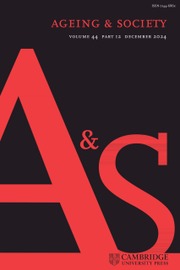No CrossRef data available.
Article contents
Future love: age(ing), gender and care in age-dissimilar couples’ imagined futures
Published online by Cambridge University Press: 04 April 2025
Abstract
Recent debates on age-dissimilar romantic relationships have centred on newly formed relationships, asking whether they reflect shifts towards more equal and individualistic love, or more malleable and self-determined understandings of age. Yet, in a global context where age dissimilarities are shifting and populations are ageing, little attention has been paid to how these understandings of love and age might play out in couples’ futures, particularly in relation to care and gender. While median marital age differences have decreased in Australia and worldwide in recent decades, there has been a rise in larger gaps. In such cases, one partner will reach old age markedly earlier than the other. This article therefore examines how age-dissimilar couples imagine their futures together. It draws on 24 in-depth interviews with women and men in heterosexual, age-dissimilar relationships in Australia, with age differences of seven to 30 years. Talking about their love relationships, interviewees – especially those in older woman relationships – avoided discussing ageing or described age as meaningless or relative. For them, they argued, appearance, experience, personality and felt age took precedence over chronology. Conversations with older interviewees exposed gaps in this logic, however, and gendered anxieties about old age and responsibility for care. Interviewees’ discussions of their futures thus highlighted tensions in understandings about age(ing), gender, care and love. Love was thought to transcend age differences and facilitate care responsibilities for some but not others. Utilising the concepts of democratisation, responsibility and gendered double standards of ageing and care, this article complicates conceptions wherein age dissimilarities are seen to typify the growing meaninglessness of age and gendered equality of love.
- Type
- Article
- Information
- Copyright
- © The Author(s), 2025. Published by Cambridge University Press.


